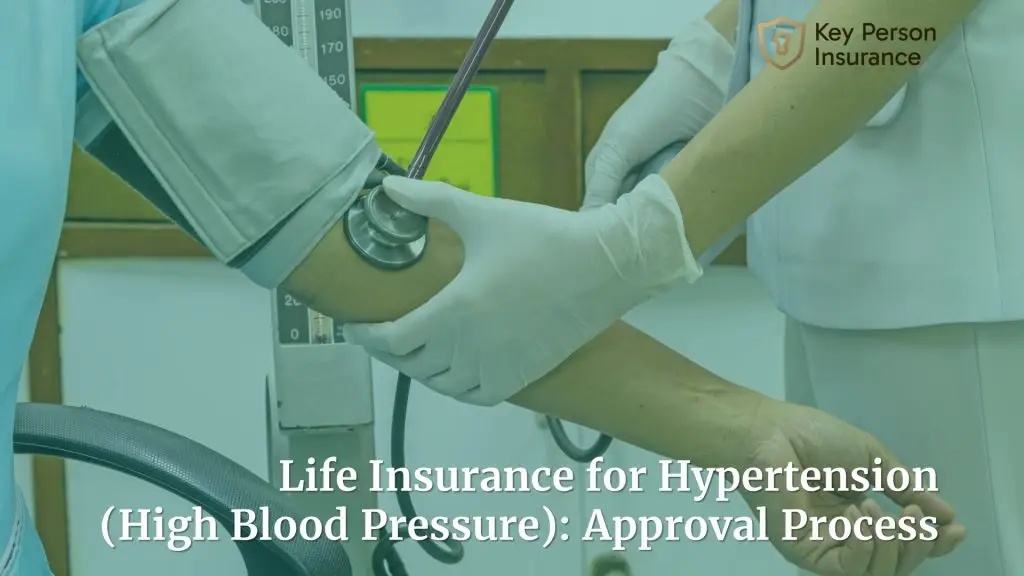High blood pressure can be a concern when looking for life insurance coverage, but it’s not an insurmountable one. Many people with high blood pressure can still secure life insurance with reasonable rates and good coverage. By understanding how insurers view high blood pressure and what you can do to improve your premiums, you can make informed decisions about protecting your family’s financial future.
Insurers assess the risk of applicants with high blood pressure by looking at how well it is managed along with other health factors. This means that keeping your blood pressure under control can positively influence your life insurance rates. Finding the right policy requires knowing which factors affect your premiums and how to present a strong application.
Key Takeaways of Life Insurance for Hypertension (High Blood Pressure)
- A life insurance company will assess how well high blood pressure is managed when determining coverage and rates.
- Maintaining a healthy lifestyle can positively impact your eligibility and help lower insurance premiums.
- A recent, stable blood pressure reading can improve your chances of approval.
- If you’ve been denied life insurance, guaranteed issue life insurance offers an alternative without medical exams.
- Comparing policy options is essential to finding the right fit for your health status and financial goals.
High Blood Pressure and Its Health Impact
High blood pressure, or hypertension, is a significant medical condition that affects a person’s health. It’s linked to serious diseases such as heart disease and diabetes. Understanding what causes high blood pressure and its effects can help individuals manage their health better.
What Is High Blood Pressure?
High blood pressure is a condition where the force of blood against artery walls is too high. Blood pressure readings above 140/90 mmHg are generally considered high. It’s often called the “silent killer” because it may not show symptoms but can lead to severe health issues over time.
When the heart pumps, it creates pressure that pushes blood through the arteries, veins, and capillaries. The pressure is highest during each heartbeat (systolic) and falls when the heart is at rest between beats (diastolic). Keeping these numbers in check is crucial for good heart health.
Common Risk Factors for Hypertension
Several factors contribute to the risk of developing high blood pressure. Obesity, a diet high in salt, and lack of physical activity play significant roles. A family history of hypertension can also increase the risk.
Lifestyle choices, like excessive alcohol consumption and smoking, are common contributors. Additionally, medical conditions such as diabetes and high cholesterol can worsen the risk. Identifying and managing these factors early can prevent the progression of hypertension.
Long-Term Effects on Health
Unchecked high blood pressure can lead to a variety of health problems. It increases the risk of heart disease by damaging arteries and the heart itself. This damage can lead to conditions like heart attack, stroke, and heart failure.
Hypertension can also harm the kidneys, leading to kidney disease. It affects other organs as well, causing problems like vision loss and cognitive issues. Managing blood pressure through lifestyle changes and medication is essential in reducing these long-term risks.

How Insurers Assess Applicants with High Blood Pressure
When applying for life insurance, individuals with high blood pressure often undergo a detailed assessment. This involves understanding the underwriting process, medical exams, health screenings, and reviewing medical records. Each step helps insurers determine the level of risk and the appropriate premium rates for applicants.
The Underwriting Process Explained
The underwriting process is crucial for life insurance companies. It helps evaluate the risk associated with insuring someone with high blood pressure. Insurers look into several factors such as age, blood pressure levels, and overall health to make their decisions.
Underwriting guidelines are used to decide if an applicant fits into their risk categories. Controlled hypertension can often result in better rates if other health metrics are favorable. Pre-existing medical conditions are also considered to understand how they may impact life expectancy.
Medical Exams and Health Screenings
Medical exams are a standard part of applying for life insurance with high blood pressure. Insurers require these exams to capture accurate health data. Health screenings typically include blood tests, urine tests, and blood pressure checks.
These exams help verify the applicant’s current health status. Applicants with controlled hypertension, where lifestyle changes or medications keep blood pressure stable, might receive more favorable terms. This is because the risk is considered lower than if the condition were uncontrolled.
Reviewing Your Medical Records
Insurers place significant importance on medical records when assessing applicants with high blood pressure. These records provide a comprehensive history of blood pressure readings, treatments, and any pre-existing conditions. This information helps insurers understand how long the applicant has had high blood pressure and how well it is managed.
Medical records also reveal other critical health details, such as medications used and any hospital visits related to heart or blood pressure issues. Insurers look at how well the applicant’s condition is controlled over time, which can influence the terms offered for life insurance coverage.
Factors That Influence Life Insurance Premiums
Life insurance premiums are determined by several key factors. These factors can impact the cost and availability of coverage. Understanding them can help in making informed decisions.
Age and Gender
Age plays a significant role in determining life insurance premiums. The younger an individual is when applying, the lower the premium is likely to be. Insurers consider younger people to have a lower risk of health problems and a longer life expectancy.
Gender also impacts premiums. Typically, women pay less than men because statistically, they live longer. This means insurance companies expect to pay out fewer claims in a shorter timeframe for female policyholders. The disparity in costs reflects these risk assessments and life expectancy calculations.
Lifestyle and Habits
Lifestyle choices hugely influence insurance premiums. Smoking and alcohol consumption lead to higher premiums because they increase the risk of health problems like cancer and liver disease. Smoking specifically is flagged due to its link with numerous serious conditions, which can shorten lifespan and increase the likelihood of early claims.
Weight and height are also evaluated to assess overall health. Being overweight or obese can lead to higher premiums as it’s often associated with conditions such as diabetes and heart disease. Occupations deemed risky or stressful can further affect insurance costs since they might contribute to issues like anxiety or depression.
Other Medical Conditions
Existing medical conditions significantly impact life insurance costs. Conditions such as high blood pressure, asthma, and depression are all considered when calculating premiums. For each, insurers evaluate the severity and management of the condition, which could suggest future health risks.
Chronic diseases often lead to higher premiums as they may require ongoing treatment and increase the possibility of early claims. Serious conditions like cancer are scrutinized closely, and insurers may require additional medical documentation to fully understand the potential risks involved before finalizing the policy.
Types of Life Insurance Policies and Coverage Options
Choosing the right life insurance policy is crucial, especially for those with high blood pressure. Different types of life insurance provide unique benefits and coverage options.
Term Life Insurance
Term life insurance offers straightforward, temporary coverage. It provides financial protection for a specific period, usually ranging from 10 to 30 years. This type of policy is often sought because it typically comes with more affordable coverage than permanent options.
Many people with high blood pressure find the lower life insurance rates appealing since it allows them to secure necessary insurance coverage without a significant financial burden. Insurers decide the premium based on factors like age, health, and lifestyle. Regular medical evaluations may be needed to maintain the policy.
Permanent Life Insurance Products
Permanent life insurance products include whole life and universal life policies. Unlike term life, these provide ongoing coverage that lasts a lifetime. Whole life insurance comes with fixed premiums and a cash value component that grows over time. This can be beneficial for those seeking stability and an investment aspect.
Universal life insurance is more flexible, allowing adjustments in premiums and coverage amounts. Individuals with high blood pressure might consider these options if they desire long-term security and are willing to pay higher premiums for lifetime coverage. Certain insurers also provide guaranteed issue life insurance, which requires no medical exams, making it an option for those who struggle with approval.
Comparing Insurance Coverage Choices
When comparing insurance coverage choices, it’s important to consider the differences between term and permanent policies. Term life insurance is generally more cost-effective but lacks the investment component of permanent policies. On the other hand, permanent life insurance products offer stable premiums and the potential for cash value accumulation.
High blood pressure patients should weigh the benefits of lower premiums with term life against the long-term benefits of permanent products, including possible return on cash value. Factors like health status, policy duration, and budget will influence the decision. Seeking advice from professionals within the insurance industry can also provide personalized insights tailored to an individual’s needs.
Tips for Getting the Best Life Insurance Rates with High Blood Pressure
Finding affordable life insurance can be tricky with high blood pressure. However, taking steps to manage health, making lifestyle changes, and shopping around can help improve the chances of getting better rates.
Managing Your Health and Blood Pressure
Keeping track of health history is essential. Regular check-ups with a doctor can help monitor blood pressure levels. Doctors usually suggest maintaining a blood pressure below 140/90 mmHg.
Following a healthy diet, low in salt and high in fruits and vegetables, is beneficial. Staying on top of prescribed medications is critical to keeping blood pressure in check. Regular visits to the healthcare provider show responsibility in managing health, which can improve chances of securing better insurance premiums.
Lifestyle Changes for Better Rates
Making lifestyle changes can lower risk factors linked to high blood pressure. This includes engaging in regular physical activity, such as walking, jogging, or biking for at least 30 minutes a day.
Cutting down on alcohol intake and quitting smoking are also vital steps. Insurance companies often reward applicants who lead healthier lifestyles with better rates. Losing excess weight can be another effective way to reduce blood pressure.
Shopping for Competitive Insurance Quotes
It’s important to shop around for competitive insurance quotes. Each insurance company evaluates risk factors differently, so getting multiple quotes can help find the most suitable option.
Using an online platform, can streamline the process. They compare rates from different providers, ensuring applicants find the best deal. Those who actively manage their health and show improvements in their lifestyle may also appeal to a wider range of insurers, thus increasing their chances of obtaining favorable rates.
Frequently Asked Questions about Life Insurance for Hypertension (High Blood Pressure)
How Does High Blood Pressure Impact the Cost of Life Insurance?
High blood pressure may increase life insurance premiums. Insurers might view it as a health risk, affecting their assessment of insurability. People with well-managed blood pressure can still find competitive rates, especially if they maintain good overall health.
What Are the Blood Pressure Limits for Qualifying for Life Insurance?
The blood pressure limits for life insurance vary by insurer. Generally, if your blood pressure is moderately high but controlled, you might still qualify for good rates. It’s important to check with each insurer about their specific guidelines.
Can You Be Disqualified from Life Insurance Due to High Blood Pressure?
High blood pressure alone rarely disqualifies someone from getting life insurance. It’s usually one of multiple factors considered. If blood pressure is controlled and other health indicators are favorable, qualification is likely.
What Tips Can Help Lower Blood Pressure Before a Life Insurance Medical Exam?
Certain habits may help lower blood pressure before an exam. Reducing salt intake, regular exercise, and managing stress can be beneficial. It may also help to avoid caffeine right before the exam to prevent temporary spikes.

Conclusion and Summary of Life Insurance for Hypertension (High Blood Pressure): Approval Process
Securing life insurance with high blood pressure is not only possible, it’s achievable with the right steps. A life insurance company will carefully evaluate your health history, including your most recent blood pressure reading, to determine eligibility and rates. Maintaining a healthy lifestyle plays a major role in improving your chances of approval and securing favorable premiums.
For those who are denied life insurance through traditional underwriting, options like guaranteed issue life insurance offer a way to get coverage without medical exams. Whether you’re managing hypertension or working toward better health, there are policy options available that can provide peace of mind and long-term protection for your loved ones.
trusted by 5,000+ clients
Get Personalized Quotes Tailored to Your Company’s Needs









